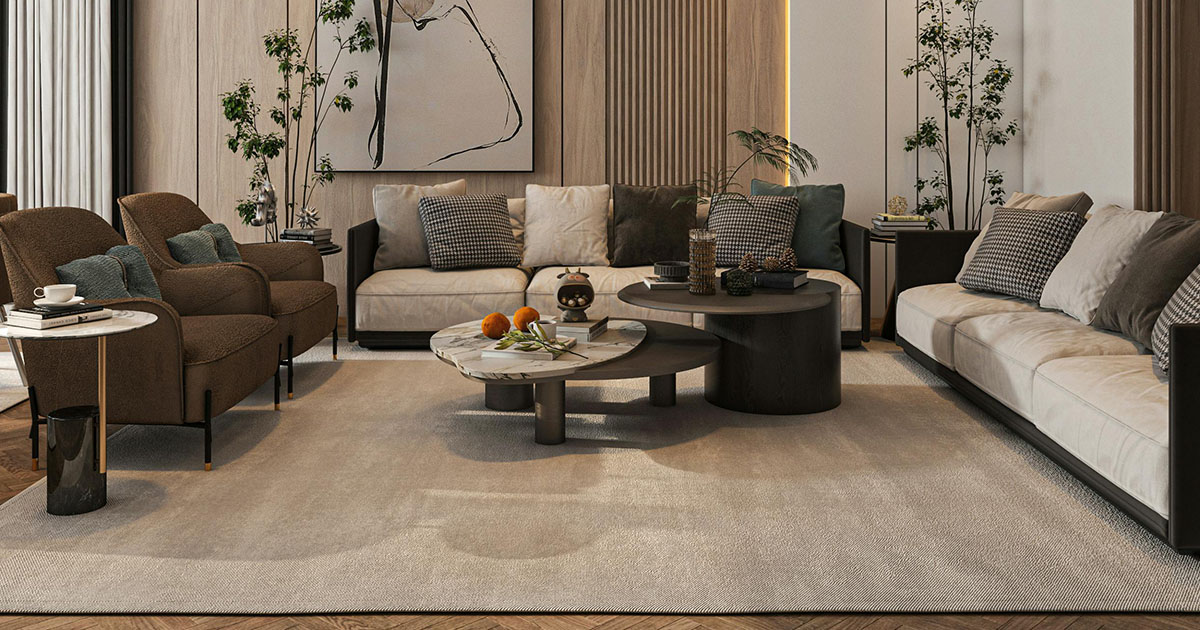Choosing the right rug size is often the most challenging part of rug shopping.
Whether you’re furnishing your home or selecting rugs for a business space, this guide will help you understand standard rug dimensions and how to select the perfect size for any room.
Common Rug Shapes
Before diving into specific measurements, let’s review the four main rug shapes you’ll encounter:
- Rectangular – The most common and versatile shape
- Runner – Long and narrow, perfect for hallways
- Round – Great for circular spaces or as statement pieces
- Square – Ideal for square rooms or under square tables
Standard Rectangular Rug Sizes
Rectangular rugs come in standard sizes that work for various spaces.
Here are the most common sizes you’ll find:
Small Rugs (Accent Rugs)
2′ x 3′ (60 x 90 cm) – Perfect for entryways, bathrooms, or as door mats
3′ x 5′ (90 x 150 cm) – Great for small spaces like foyers or beside beds
Medium Rugs
4′ x 6′ (120 x 180 cm) – Works well in apartments, reading nooks, or under coffee tables
5′ x 8′ (150 x 240 cm) – Popular for smaller living rooms or under twin/full beds
Large Rugs
6′ x 9′ (180 x 270 cm) – Excellent for medium living rooms and dining areas
8′ x 10′ (240 x 300 cm) – One of the most popular sizes for living rooms in North America
Extra-Large Rugs
9′ x 12′ (270 x 365 cm) – Ideal for spacious living rooms or under king-size beds
10′ x 14′ (300 x 420 cm) – Perfect for grand rooms or large seating arrangements
Runner Rugs
Runner rugs typically measure:
- Width: 2′ to 3′ (60 to 90 cm)
- Length: Various options from 6′ to 14′ (180 to 420 cm)
Common runner sizes include:
- 2’6″ x 8′ (75 x 240 cm) – Standard hallway runner
- 2’6″ x 10′ (75 x 300 cm) – For longer hallways
- 3′ x 12′ (90 x 365 cm) – For grand entryways or extra-long hallways
Round Rugs
Round Rugs (measured by diameter)
4′ (120 cm) – Small accent rug
6′ (180 cm) – Medium size, works under small dining tables
8′ (240 cm) – Large size for defining seating areas
Square Rugs
4′ x 4′ (120 x 120 cm) – Small accent rug
6′ x 6′ (180 x 180 cm) – Medium size for square spaces
8′ x 8′ (240 x 240 cm) – Larger option for square rooms or under square dining tables
Room-by-Room Size Guide
Living Room Rug Sizes
Small living rooms: 5′ x 8′ (150 x 240 cm) or 6′ x 9′ (180 x 270 cm)
Average living rooms: 8′ x 10′ (240 x 300 cm)
Large living rooms: 9′ x 12′ (270 x 365 cm) or larger
Best practice:
Choose a rug large enough that at least the front legs of all furniture sit on it. For a more luxurious feel, select a size where all furniture legs rest on the rug.
Dining Room Rug Sizes
4-6 person table: 8′ x 10′ (240 x 300 cm)
6-8 person table: 9′ x 12′ (270 x 365 cm)
Round tables: Use a round rug that extends about 24″ (60 cm) beyond the table edge
Best practice:
Ensure the rug extends at least 24″ (60 cm) beyond all sides of the table so chairs remain on the rug when pulled out.
Bedroom Rug Sizes
Twin/Full bed: 5′ x 8′ (150 x 240 cm) or 6′ x 9′ (180 x 270 cm)
Queen bed: 8′ x 10′ (240 x 300 cm)
King bed: 9′ x 12′ (270 x 365 cm)
Best practice:
Position the rug so it extends 18-24″ (45-60 cm) beyond the sides of the bed. Alternatively, use runner rugs (2′ x 6′ or 75 x 180 cm) on each side of the bed.
Regional Differences
- North America typically uses imperial measurements (feet/inches) and favors larger rugs
- Europe uses metric measurements (cm/m) and often works with slightly smaller rugs due to room dimensions
- Middle East traditionally uses larger rugs that cover most of the floor space, with just a border of flooring showing
Business and Commercial Spaces
Office Rug Sizes
Under desk area: 5′ x 8′ (150 x 240 cm) or 6′ x 9′ (180 x 270 cm)
Executive office: 8′ x 10′ (240 x 300 cm) or 9′ x 12′ (270 x 365 cm)
Conference room: Choose a rug large enough to accommodate all chairs when pulled out
Hotel and Hospitality Spaces
Lobby seating areas: 9′ x 12′ (270 x 365 cm) or larger
Hotel rooms: Similar to residential bedroom sizes
Restaurant dining areas: Ensure rug extends 24-30″ (60-75 cm) beyond tables
Quick Placement Tips
Leave 12-24″ (30-60 cm) of floor visible around the edges of the rug for balance
Avoid “postage stamp” syndrome – a rug that’s too small throws off room proportions
When in doubt, go larger rather than smaller
Consider traffic patterns when placing rugs in hallways and entryways
For open-concept spaces, use rugs to define and separate different functional areas
By understanding standard rug sizes and how they work in different spaces, you’ll be able to shop more confidently and select the perfect rug for any room. Remember that these guidelines are flexible – your personal style and space requirements should always be the final deciding factors.




